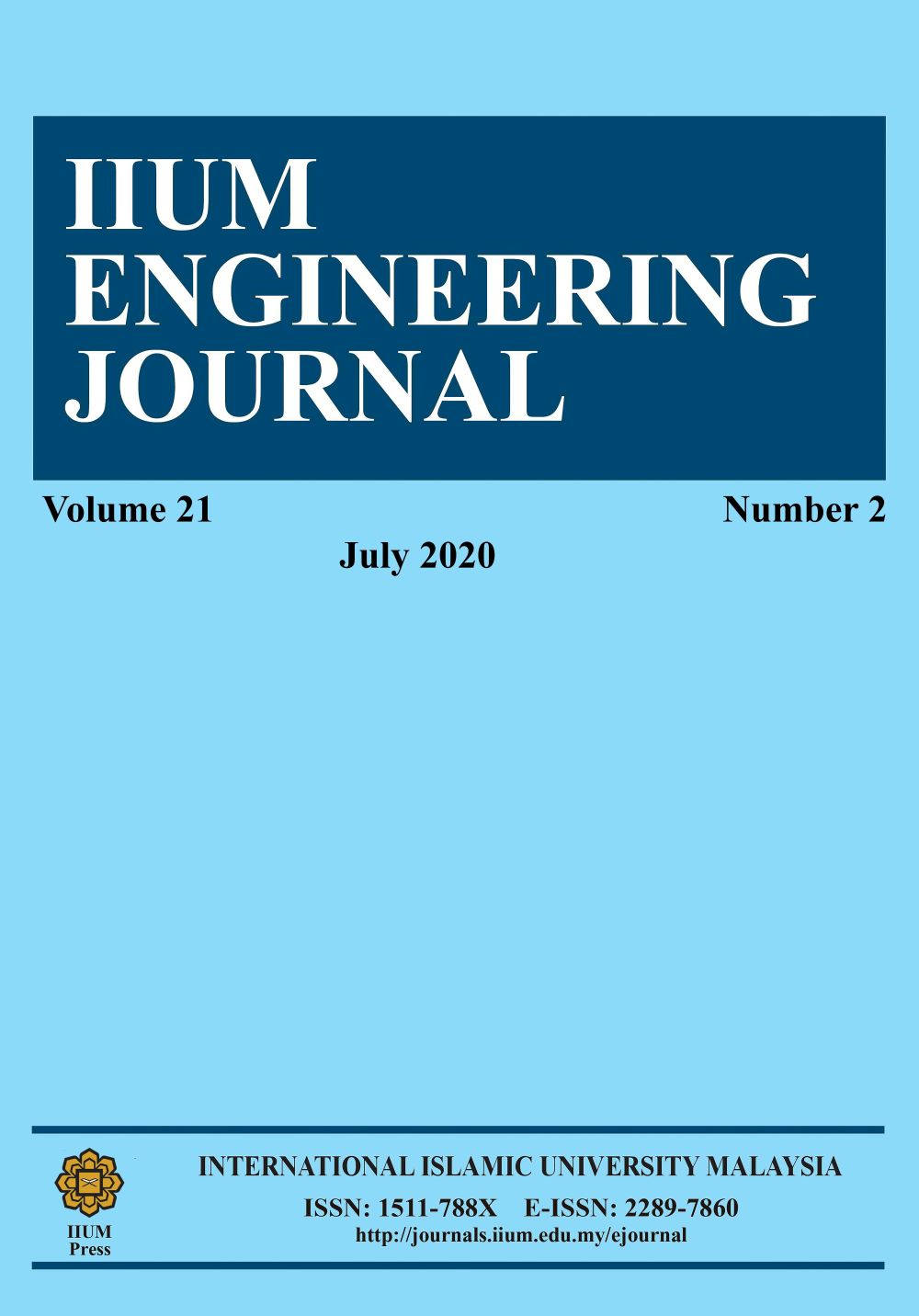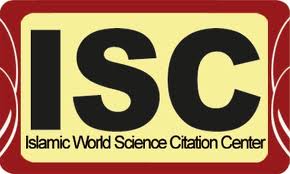BIODELIGNIFICATION OF LEMON PEELS USING Aspergillus sp. TO IMPROVE YIELD AND COMPOSITION OF EXTXRACTED LEMON OIL
DOI:
https://doi.org/10.31436/iiumej.v21i2.1320Keywords:
Aspergillus sp;, biodelignification;, lemon oil;, lemon peels;, lignin contentAbstract
Lemon oil obtained from lemon peels has a high market value. However, the presence of lignocellulose composed of cellulose, hemicellulose, and lignin, can inhibit the extraction process. This study aimed to determine the effect of biodelignification on lemon peels using Aspergillus sp. towards lignin content, yield, chemical composition, and productivity of lemon oil. A solid-state fermentation was carried out under controlled relative humidity of 99% and a light intensity of ~0 W/cm2 for 0, 3, 6, and 9 days. The number of spores used was in the range of 0.3-5 x 105 spores/gram substrate with a ratio of spore solution and substrate of 1:1. Extraction was performed using a steam distillation method at 97-98°C for 6 hours. The results showed that the lignin content decreased with an increased fermentation time: 8.01%, 6.97-7.28%, 5.83-7.28%, and 4.35-5.44% dry weight for day 0, 3, 6, and 9, respectively. Lemon oil yield increased as the period of fermentation increased up to 0.27%, 0.29-0.31%, 0,30-0.46%%, and 0.67-0.79% for day-0, 3, 6, and 9, respectively. A major component of lemon oil is d-limonene. The d-limonene content reached 72,54% for day-0, 73-99% for day-3, 75,09-84.59% for day-6, and 88,03-99% for day-9.
ABSTRAK: Minyak lemon yang terhasil dari kupasan lemon mempunyai nilai tinggi dalam pasaran. Walau bagaimanapun, kehadiran lignoselulosa yang terdiri daripada selulosa, hemiselulosa dan lignin, boleh merencatkan proses pengekstrakan. Kajian ini bertujuan memperolehi kesan biodelignifikasi pada kulit lemon menggunakan Aspergillus sp. terhadap kandungan lignin, hasil, komposisi kimia, dan penghasilan minyak lemon. Penapaian keadaan-pepejal dijalankan di bawah 99% kawalan kelembapan relatif dan keamatan cahaya ~0 W/cm2 bagi 0, 3, 6 dan 9 hari. Bilangan spora yang digunakan adalah dalam lingkungan substrat 0.3-5 x 105 spora/gram dengan nisbah larutan spora kepada substrat adalah 1:1. Pengekstrakan dijalankan menggunakan kaedah penyulingan stim pada suhu 97-98°C selama 6 jam. Keputusan menunjukkan kandungan lignin berkurangan dengan pertambahan masa penapaian: 8.01%, 6.97-7.28%, 5.83-7.28%, dan 4.35-5.44% berat kering pada hari 0, 3, 6, dan 9, masing-masing. Hasil minyak lemon bertambah dengan pertambahan masa penapaian sehingga 0.27%, 0.29-0.31%, 0,30-0.46%%, dan 0.67-0.79% pada hari 0, 3, 6, dan 9, masing-masing. Komponen major minyak lemon adalah d-limonina. Kandungan d-limonina mencapai 72,54% pada hari-0, 73-99% pada hari-3, 75,09-84.59% pada hari-6, dan 88,03-99% pada hari-9.
Downloads
Metrics
References
Pratiwi A, Utami L. (2018) Isolasi dan Analisis Kandungan Minyak Atsiri pada Kembang Leson. Bioeksperimen 4 (1): 42-47. https://doi.org/10.23917/bioeksperimen.v4i1.5930
Grand View Research. (2018) Essential Oils Market Size, Share & Trends Analysis Report by Product (Orange, Corn, Mint, Eucalyptus, Citronella, Pepper Mint, Lemon, Clove Leaf, Lime, Spearmint), by Application, and Segment Forecasts, 2018-2025. https://www.grandviewresearch.com
Rosiantiningsih D. (2017) Minyak Atsiri, Emas Terpendam Indonesia. http://marketplus.co.id/2017/03/minyak-atsiri-emas-terpendam-indonesia/.
González-Molina E, Domínguez-Perles R, Moreno DA, García-Viguera C. (2010) Natural Bioactive Compounds of Citrus limon for Food and Health. J. Pharmaceutical and Biomedical Analysis, 51 (2): 327-345. https://doi.org/10.1016/j.jpba.2009.09.049
Nurlaila A. (2001) Upaya Pemanfaatan Limbah Jus Jeruk Lemon (Citrus limon (Linn) Burm. F.) sebagai Bahan Baku Pengolahan Jeruk Lemon. Bogor, Institut Pertanian Bogor. http://repository.ipb.ac.id/handle/123456789/13152
Sonneman T. (2012) Lemon A Global History. London, Reaktion Books Ltd.
Transparency Market Research. (2019) Lemon Essential Oil Market to Expand at 5.5%
CAGR During 2018-2027. https://www.prnewswire.com
Gök A, Kirba?lar IFGK. (2014) Comparison of Lemon Oil Composition After Using Different Extraction Method. Journal of Essential Oil Research, 27(1): 17-22. https://doi.org/10.1080/10412905.2014.982872
Sikdar D, Nikila R. (2017) Extraction of Citrus Oil from Lemon (Citrus limon) Peels by Steam Distillation and Its Characterizations. International Journal of Technical Research and Applications, 5(2): 29-33. https://pdfs.semanticscholar.org
Dosoky NS, Setzer WN. (2018) Biological Activities and Safety of Citrus spp. Essential Oils. International Journal of Molecular Sciences, 19 (7): 1966-1991. https://doi: 10.3390/ijms19071966.
Janati SSSF, Beheshti H, Feizy J, Fahim N. (2012) Chemical Composition of Lemon (Citrus limon) and Peels Its Consideration as Animals Food. GIDA-Journal of Food, 37(5): 267-271. https://dergipark.org.tr
Chen H. (2014) Biotechnology of Lignocellulose: Theory and Practice. Dordrecht, Springer.
Ahammed S, Prema P. (2002) Influence of media nutrients on synthesis of lignin peroxidase from Aspergillus sp. Applied Biochemistry and Biotechnology, 327-336. https://doi.org/10.1385/ABAB:102-103:1-6:327
dos Santos TC, dos Santos RN, Silva TP, Machado FD, Bonomo RC, Franco M. (2016) Prickly palm cactus husk as a raw material for production of ligninolytic enzymes by Aspergillus niger. Food science and biotechnology, 25(1): 205-211. https://doi.org/10.1007/s10068-016-0031-9
Shah MP, Reddy GV, Banerjee R, Babu PR., Kothari IL. (2005) Microbial degradation of banana waste under solid state bioprocessing using two lignocellulolytic fungi (Phylosticta spp. MPS-001 and Aspergillus spp. MPS-002). Process Biochemistry, 40(1): 445-451. https://doi.org/10.1016/j.procbio.2004.01.020
Mrudula S, Murugammal R. (2011) Production of cellulase by Aspergillus niger under submerged and solid state fermentation using coir waste as a substrate. Brazilian Journal of Microbiology, 7:1119-1127. https://doi.org/10.1590/S1517-83822011000300033
Botella C, Diaz A, de Ory I, Webb C, Blandino A. (2007) Xylanase and Pectinase Production by Aspergillus awamori on Grape Pomace in Solid State Fermentation. Process Biochemistry 42 (1): 98-101. https://doi.org/10.1016/j.procbio.2006.06.025
Steviani S. (2011) Pengaruh penambahan molase dalam berbagai media pada jamur tiram putih (Pleurotus ostreatus). Surakarta, Universitas Sebelas Maret. https://digilib.uns.ac.id
Silva R. (2016) Mycology: Current and Future Developments: Fungal Biotechnology for Biofuel Production Volume 1. Sharjah, Benthan Science Publishers.
Zambare V. (2010) Solid state fermentation of Aspergillus oryzae for glucoamylase production on agro residues. International Journal of Life Sciences, 16-25. https://doi.org/10.3126/ijls.v4i0.2892
Abduh MY, Zuliansyah W, Aprina L, Arazella N. (2019) Effect of pectin biodegradation with Aspergillus niger on total flavonoid content of Citrus limon L. J Biodjati, 4(2):194-203. https://doi.org/10.15575/biodjati.v4i2.4537
Gwalingo E, Rahman NSA, Al-Marzouqi AH, Omar MMA, Khaleel AA. (2018) Klason method: an effective method for isolation of lignin fractions from date palm biomass waste. Chemical and Process Engineering Research, 57:46-58. https://www.iiste.org/Journals/index.php/CPER/article/view/41830
Carneiro JD, Noguera RM, Martins MA, Valladão DM, Pires EM. (2018) The Oven-Drying method for Determination of Water Content in Brazil Nut. Bioscience Journal 34 (3), 595-602. https://doi.org/10.14393/BJ-v34n3a2018-37726
Kandi M, Sefidkon F. (2011) The influence of drying methods on essential oil content and composition of Laurus nobilis L. Journal of Essential Oil Bearing Plants, 14 (3), 302-308. https://doi.org/10.1080/0972060X.2011.10643938
Rahimmalek M, Goli SA. (2013) Evaluation of Six Drying Treatments with Respect to Essential Oil Yield, Composition and Color Characteristics of Thymys daenensis subsp. daenensis. Celak Leaves. Industrial Crops and Products, 42(1): 613-619. https://doi.org/10.1016/j.indcrop.2012.06.012
Ambrose DC, Annamalai S, Naik R. (2013) Effect of Drying on Volatile Oil Yield of Patchoulli. Indian Journal of Science and Technology, 6(12): 5559-5562. http://52.172.159.94/index.php/indjst/article/view/43613
Hobir Y, Nuryani E, Anggraeni. (2003) Peningkatan Produktivitas dan Mutu Minyak Nilam Melalui Perbaikan Varietas dan Teknik Pengolahan. Balitro, Bogor.
Hamrouni-Sellami I, Wannes WA, Bettaieb I, Berrima S, Chahed T, Marzouk B, Limam F. (2011) Drying Sage (Salvia officinalis L.) Plants and Its Effects on Content, Chemical Composition, and Radical Scavenging Activity of the Essential Oil. Food and Bioprocess Technology, 5(8): 2978-2989. https://pubag.nal.usda.gov/catalog/448611
Hasmita I, Adisalamun A, Alam PN, Satriana S, Mahlinda M, Supardan, M. D. (2015) Effect of Drying and Hydrodistillation Time on the Amount of Ginger Essential Oil. International Journal on Advanced Science, Engineering, and Information Technology, 5(5): 300-303. http://dx.doi.org/10.18517/ijaseit.5.5.567
Ferreira FL, Dall'Antonia CB, Shiga EA, Alvim LJ, Pessoni RA. (2018) Sugarcane Bagasse as a Source of Carbon for Enzyme Production by Filamentous Fungi. Hoehnea, 45(1): 134-142. https://doi.org/10.1590/2236-8906-44/2017
Mamma D, Christakopoulos P. (2013) Biotransformation of Citrus By-Products into Value Added Products. Waste Biomass Valorization, 5(4): 529-549. https://doi.org/10.1007/s12649-013-9250-y
Brijwani K, Rigdon A, Vadlani PV. (2010) Fungal Laccases: Production, Function, and Applications in Food Processing. Enzyme Research, 1: 1-10. https://doi.org/10.4061/2010/149748
Chávez-González ML, López LI, Rodríguez-Herrera R, Contreras-Esquivel JC, Aguilar CN. (2015) Enzyme-Assisted Extraction of Citrus Essential Oil. Chemical Papers, 70(4): 1-10. https://doi.org/10.1515/chempap-2015-0234
Boughendjioua H, Djeddi S. (2017) Organoleptic and Physicochemical Properties of Algerian Lemon Essential Oil. World Journal of Applied Chemistry, 2(3): 96-100. https://doi.org/10.11648/j.wjac.20170203.14
Wilkins MR, Grohmann K, Widmer WW. (2006) Effect of d-limonene on the Fermentation of Citrus Peel Waste. American Society of Agricultural and Biological Engineers, 1(1): 1-7. https://doi.org/10.1080/15435075.2017.1307753
Lota ML, de Rocca SD, Tomi F, Jacquemond C, Casanova J. (2002) Volatile Components of Peel and Leaf Oils of Lemon and Lime Species. Journal of Agricultural and Food Chemistry, 50(4): 796–805. https://doi.org/10.1021/jf010924l
Ferhat MA, Meklati BY, Smadja J, Chemat F. (2006) An Improved Microwave Clevenger Apparatus for Distillation of Essential Oils from Orange Peel. Journal of Chromatography A, 1112 (1): 121-126. https://doi.org/10.1016/j.chroma.2005.12.030
Díaz AB, Ory ID, Caro I, Blandino A. (2012) Enhance Hydrolytic Enzymes Production by Aspergillus awamori on Supplemented Grape Pomace. Food and Bioproducts Processing, 90(1): 72-78. https://doi.org/10.1016/j.fbp.2010.12.003
Tang PL, Hassan O, Maskat MY, Badri K. (2015) Production of Monomeric Aromatic Compounds from Oil Palm Empty Fruit Bunch Fiber Lignin by Chemical and Enzymatic Methods. Biomed Research International, 5: 1-14. https://doi.org/10.1155/2015/891539
Downloads
Published
How to Cite
Issue
Section
License
Copyright (c) 2020 IIUM Press

This work is licensed under a Creative Commons Attribution 4.0 International License.






















